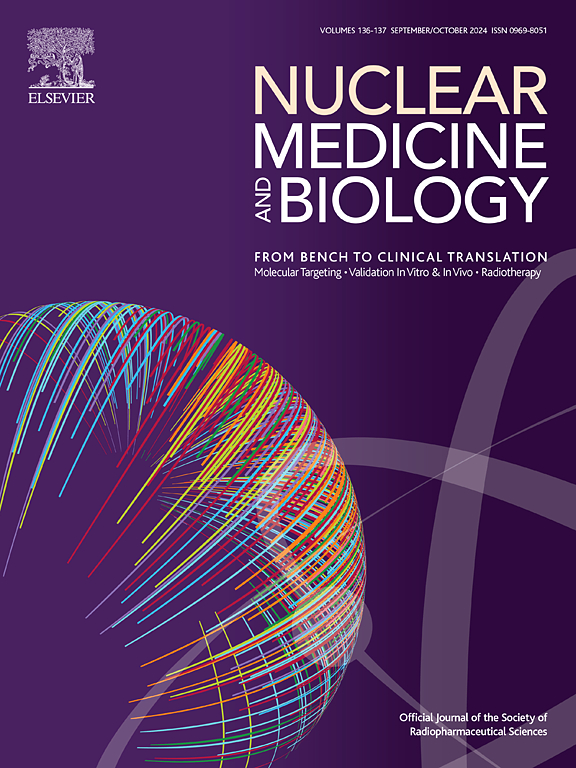Myocardial kinetics of [11C]β-hydroxybutyrate in healthy pigs: Comparison of positron emission tomography imaging vs. arteriovenous balance methods
IF 3
4区 医学
Q1 RADIOLOGY, NUCLEAR MEDICINE & MEDICAL IMAGING
引用次数: 0
Abstract
Background
Accurate assessment of myocardial ketone uptake and oxidation is essential for understanding cardiac metabolism. This study aims to validate positron emission tomography (PET) imaging as a non-invasive method for quantifying myocardial ketone metabolism, using the invasive arteriovenous (AV) balance method as reference.
Methods
Myocardial ketone uptake was assessed using [11C]β-hydroxybutyrate ([11C]OHB) PET imaging in a porcine model. Blood samples were collected from arterial and coronary sinus sites, and kinetic parameters were calculated to evaluate the relationship between PET-derived and AV balance-derived measurements. Myocardial perfusion was assessed using [15O]water PET scans. The procedures were conducted during a graded infusion of ketone salt.
Results
A strong positive correlation between PET-derived and AV balance-derived measurements of myocardial OHB uptake was observed (r = 0.97; p < 0.0001), indicating that [11C]OHB PET imaging can reliably assess myocardial ketone metabolism. The correlation between the rate constant k2 and the [11C]CO2 fraction in coronary sinus blood was near-significant, moderate and positive (r = 0.71; p = 0.08), suggesting potential for k2 as a marker of myocardial ketone oxidation.
Conclusion
[11C]OHB PET imaging is a non-invasive tool for assessing myocardial ketone metabolism, providing valuable insights into ketone uptake and oxidation in vivo, with potential for extrapolation to human data.

健康猪[11C]β-羟基丁酸的心肌动力学:正电子发射断层成像与动静脉平衡方法的比较
准确评估心肌酮摄取和氧化对了解心脏代谢至关重要。本研究以有创动静脉(AV)平衡法为参照,验证正电子发射断层扫描(PET)成像作为一种无创定量心肌酮代谢的方法。方法采用[11C]β-羟基丁酸盐([11C]OHB) PET显像法测定猪心肌酮摄取情况。从动脉和冠状窦处采集血液样本,计算动力学参数以评估pet衍生的和AV平衡衍生的测量之间的关系。采用[15O]水PET扫描评估心肌灌注。该程序是在酮盐的分级输注过程中进行的。结果pet衍生的心肌OHB摄取与AV平衡衍生的心肌OHB摄取呈正相关(r = 0.97;p & lt;0.0001),表明[11C]OHB PET成像可以可靠地评估心肌酮代谢。速率常数k2与冠状窦血[11C]CO2分数呈接近显著、中等和正相关(r = 0.71;P = 0.08),提示k2可能是心肌酮氧化的标志。结论[11C]OHB PET成像是一种评估心肌酮代谢的无创工具,为体内酮摄取和氧化提供了有价值的见解,具有外推人体数据的潜力。
本文章由计算机程序翻译,如有差异,请以英文原文为准。
求助全文
约1分钟内获得全文
求助全文
来源期刊

Nuclear medicine and biology
医学-核医学
CiteScore
6.00
自引率
9.70%
发文量
479
审稿时长
51 days
期刊介绍:
Nuclear Medicine and Biology publishes original research addressing all aspects of radiopharmaceutical science: synthesis, in vitro and ex vivo studies, in vivo biodistribution by dissection or imaging, radiopharmacology, radiopharmacy, and translational clinical studies of new targeted radiotracers. The importance of the target to an unmet clinical need should be the first consideration. If the synthesis of a new radiopharmaceutical is submitted without in vitro or in vivo data, then the uniqueness of the chemistry must be emphasized.
These multidisciplinary studies should validate the mechanism of localization whether the probe is based on binding to a receptor, enzyme, tumor antigen, or another well-defined target. The studies should be aimed at evaluating how the chemical and radiopharmaceutical properties affect pharmacokinetics, pharmacodynamics, or therapeutic efficacy. Ideally, the study would address the sensitivity of the probe to changes in disease or treatment, although studies validating mechanism alone are acceptable. Radiopharmacy practice, addressing the issues of preparation, automation, quality control, dispensing, and regulations applicable to qualification and administration of radiopharmaceuticals to humans, is an important aspect of the developmental process, but only if the study has a significant impact on the field.
Contributions on the subject of therapeutic radiopharmaceuticals also are appropriate provided that the specificity of labeled compound localization and therapeutic effect have been addressed.
 求助内容:
求助内容: 应助结果提醒方式:
应助结果提醒方式:


